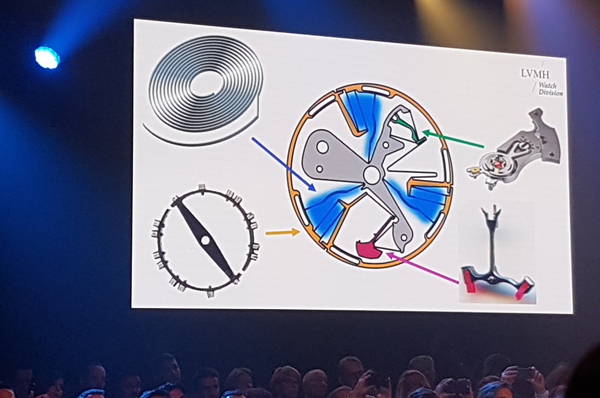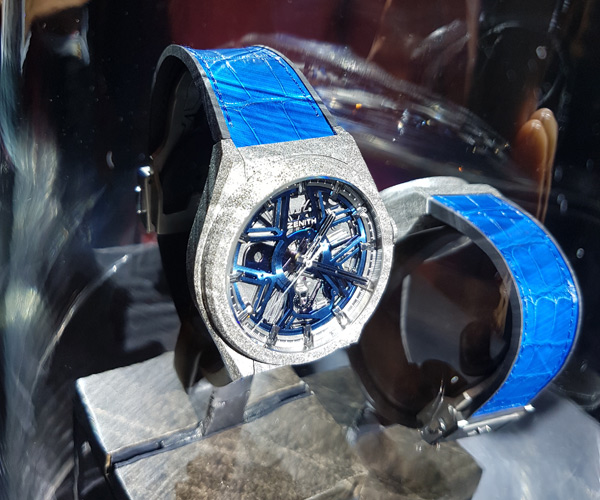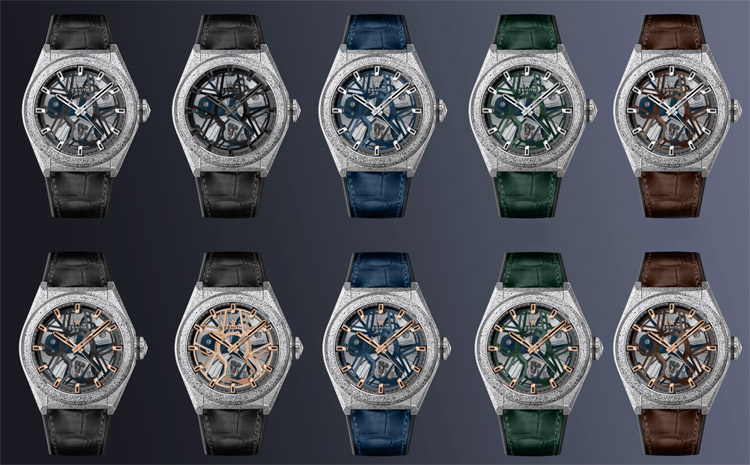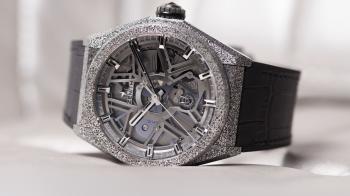On 14 September 2017, in Le Locle, Zenith unveiled a new watch which it proudly claims marks an epoch in watchmaking history. The case of the Defy Lab is made of a new material called Aeronith. Although it is spectacularly light, that is not what makes this new model so historically innovative, and in fact the new material wasn’t even discussed at the press conference, led by Aurel Bacs. No, Zenith claims it has overturned the fundamental principle of the spring balance – the regulating organ for mechanical watches perfected by Christiaan Huygens in 1675, and now in use for 342 years.
A monobloc oscillator
Yesterday, Zenith unveiled the Defy Lab and its new oscillator, developed in a collaborative venture by LVMH’s watch brands, under the leadership of Guy Sémon, CEO of the R&D Institute of LVMH’s watch division and hailed as the “new Huygens” by an enthusiastic Jean-Claude Biver. The President of LVMH’s watch division was keen to highlight the unusually synergistic work of Zenith, TAG Heuer and Hublot, symbolised by the presence alongside him of Zenith CEO Julien Tornare and Hublot CEO Ricardo Guadalupe. So, why was this new oscillator developed for Zenith, rather than one of the other two brands? “Because Zenith is the master of chronometry,” explains Jean-Claude Biver.
The new oscillator, which replaces the traditional spring balance mechanism in the Defy Lab’s new Calibre ZO 342, is made of a single piece of monocrystalline silicon, which consequently requires neither assembly, adjustment nor lubrication. Compared with the thirty or so components that make up a traditional regulator, the extreme simplicity of the Zenith oscillator is groundbreaking, but that is not its only quality. The most visible achievement is its thinness (0.5 mm compared with 5 mm), which can be appreciated through the timepiece’s open-worked dial. Its most impressive property, however, is its extremely high frequency of 15 Hz (108,000 vph), with an amplitude of +/- 6 degrees, and its resulting precision of, on average, 0.3 seconds per day. This extraordinary performance is also extremely consistent: the oscillator loses only 5% of this precision over its 60-hour power reserve. Finally, the Zenith oscillator is not affected by temperature, gravity or magnetic fields.


Metal foam
The Calibre ZO 342 of the Defy Lab, which drives the hours, minutes and central seconds (whose trajectory is extremely fluid thanks to the high frequency of the movement) is housed in an equally innovative case, made of a novel material called Aeronith, for which Hublot has registered a patent. Aeronith is a composite material made of aluminium 6082, an alloy designed for maximum corrosion resistance. The alloy is transformed into a porous metal foam via a procedure developed by Hublot’s manufacture in Nyon. A polymer is injected into the voids, creating an extremely strong and very light material (2.7 times lighter than titanium and 10% lighter than carbon fibre). Aeronith is robust but easy to machine, resistant to ultra-violet rays and hypoallergenic. The material gives the Defy Lab’s 44 mm case a pointillist finish and an appearance reminiscent of grey or black granite.

Ten unique pieces to start
Ten unique pieces, each one different from the rest, have been made to mark the launch of the Defy Lab. They feature hour markers and hands in rose gold or rhodium, a blue, green, brown, anthracite, black or rose gold skeletonised dial, and a matching strap made of rubber and alligator leather. These ten watches were pre-ordered by collectors, who were present in the room and were able to leave with their new watch on their wrist. Zenith has announced that a mass-produced version of the Defy Lab will soon be available, with a new, original design. Jean-Claude Biver emphasised the brand’s desire to produce these oscillators “in large volumes”, and its ability to do so: “We have the machines to do it, and our aim is to produce a million a year.” With these kinds of volumes, the oscillators won’t be reserved solely for brands in the LVMH stable. “We want the whole of the Swiss watch industry to be able to reap the benefits of this new oscillator,” Jean-Claude Biver concluded. “80 to 90% of our output will be sold to third parties.”








